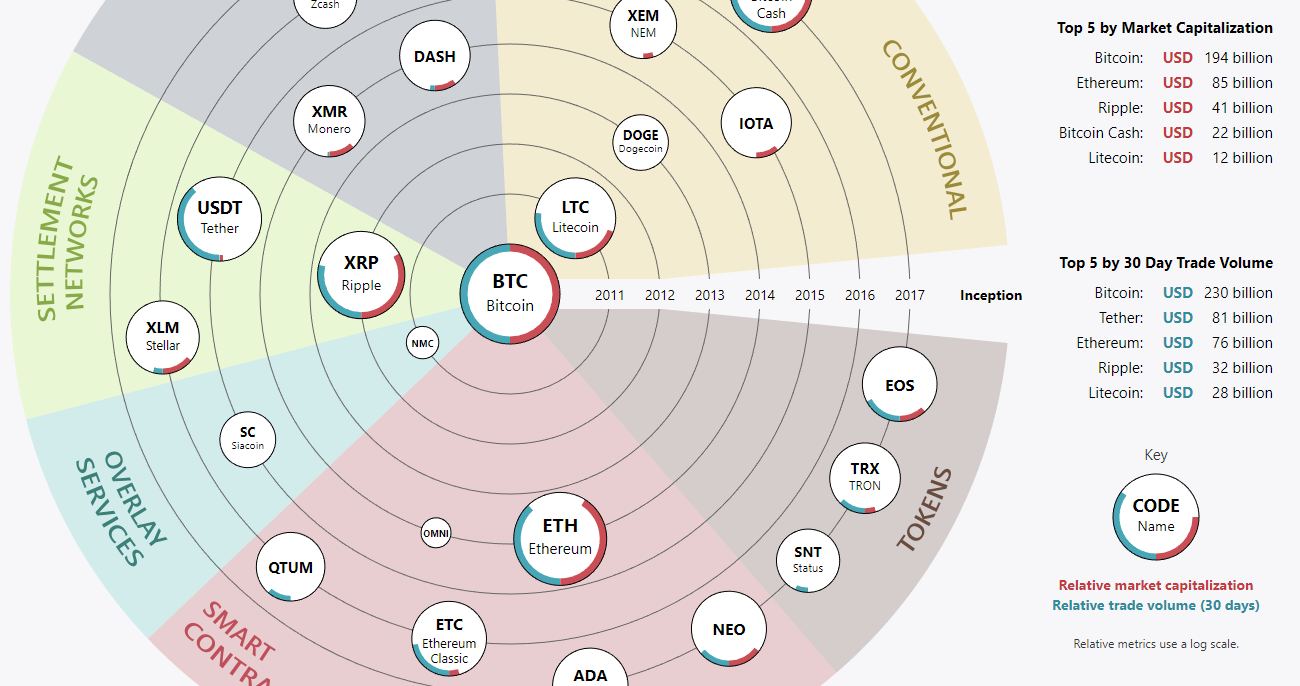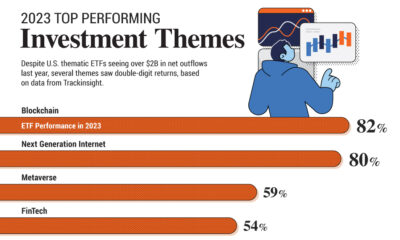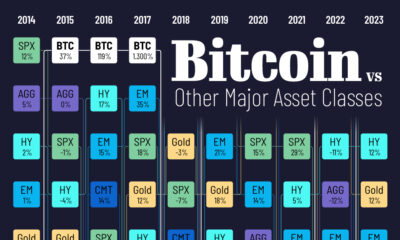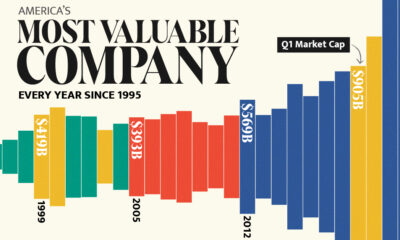Bitcoin
Comparing the 25 Most Notable Cryptocurrencies
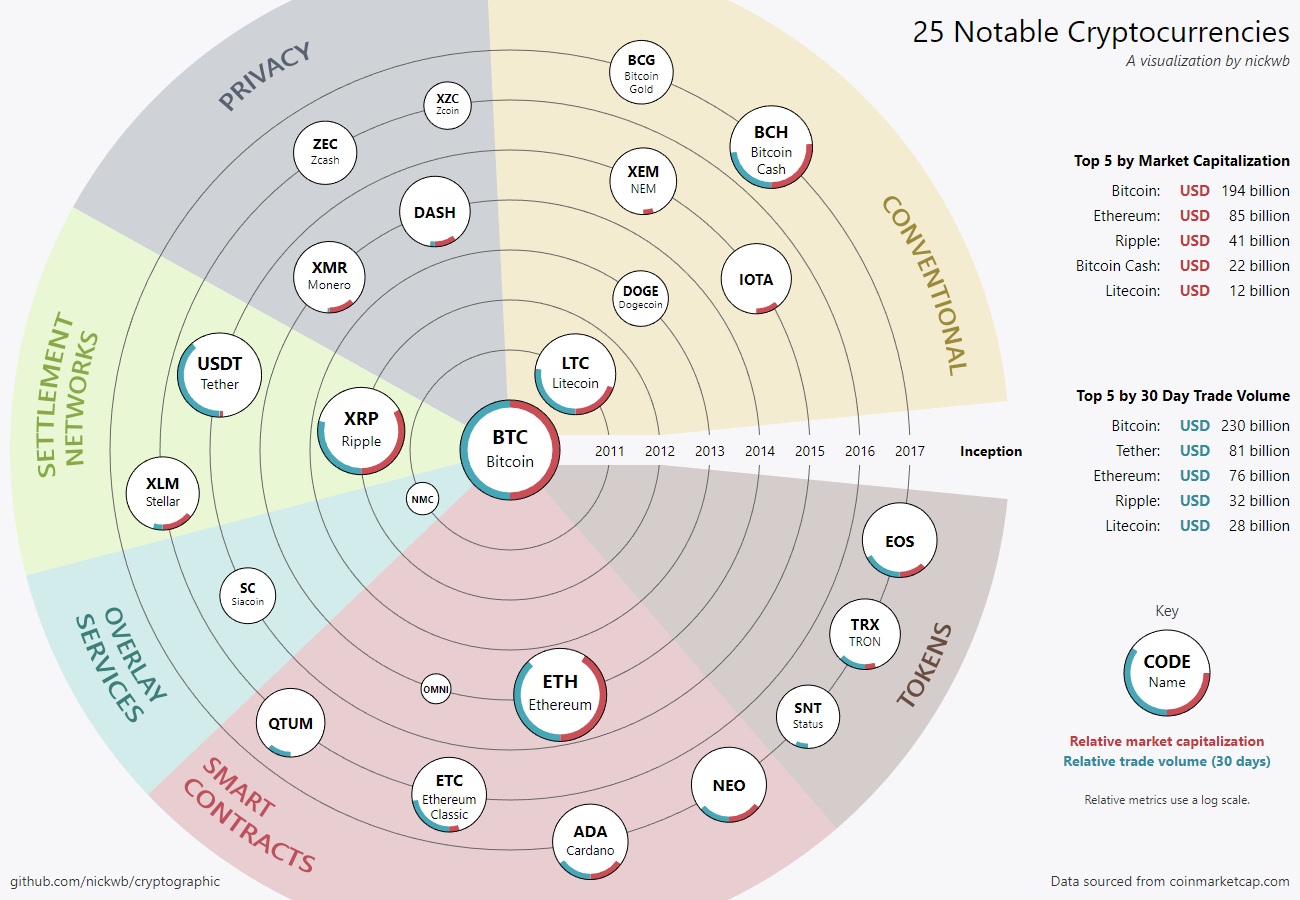
Comparing the 25 Most Notable Cryptocurrencies
Since garnering more mainstream attention, the rise of Bitcoin has been debated openly by government officials, financial institutions, and mass media outlets. A segment on Bitcoin was even recently broadcast to millions of viewers on the popular The Ellen DeGeneres Show.
While Bitcoin remains the undisputed bellwether for digital currencies, it’s also fair to say that the entire crypto landscape has been changing dramatically over the last year. New coin and token offerings have raised billions of dollars, innovative ideas are capturing the attention of investors, and there are now 20+ cryptocurrencies that have at least $1B in market capitalization.
Bitcoin may be in the public spotlight, but there’s a lot happening behind the scenes.
Most Notable Cryptocurrencies
Today’s visualization comes to us from Nick Young, and it shows the 25 most notable cryptocurrencies on the market using data from March 5, 2018.
In the graphic, the 25 cryptocurrencies are organized by market capitalization, inception date, 30-day trade volume, and also the type of function that each coin or token has. It’s also worth noting that relative comparisons are done on a log scale for easier viewing.
Here are the top five cryptocurrencies by market capitalization, according to the graphic:
| Rank | Cryptocurrency | Market Capitalization |
|---|---|---|
| #1 | Bitcoin | $194 billion |
| #2 | Ethereum | $85 billion |
| #3 | Ripple | $41 billion |
| #4 | Bitcoin Cash | $22 billion |
| #5 | Litecoin | $12 billion |
Note: Cryptocurrencies are volatile and have large swings in value, so these numbers can change quickly.
And here is the top five cryptocurrencies by 30-day volume, as well:
| Rank | Cryptocurrency | 30-Day Trade Volume |
|---|---|---|
| #1 | Bitcoin | $230 billion |
| #2 | Tether | $81 billion |
| #3 | Ethereum | $76 billion |
| #4 | Ripple | $32 billion |
| #5 | Litecoin | $12 billion |
Bitcoin’s journey to $10,000 in late 2017 caught the attention of many people in the media and investing world, catapulting the currency into the mainstream. At the same time, however, it’s also clear that the rest of the cryptocurrency landscape is flourishing as a strong supporting cast, making for a more diverse, interesting, and efficient ecosystem overall.
Exactly a year ago, Bitcoin made up over 80% of the market capitalization of the cryptocurrency space. Today, with many altcoins gaining traction (and the Bitcoin hard forks taking place), the share held by Bitcoin is closer to 42%.
Bitcoin
The 4th Bitcoin Halving Explained
We take a deep dive on historical Bitcoin data from Coinmetrics to see what lessons the 3 previous halvings might have for the future.

The 4th Bitcoin Halving Explained
Sometime in April 2024, the reward that cryptocurrency miners receive for mining bitcoin (BTC) will go from ₿6.25 to ₿3.125, with significant consequences for the world’s most valuable digital currency.
To help understand this quadrennial event, we’ve teamed up with HIVE Digital to take a deep dive on historical bitcoin data from Coinmetrics to see what the three previous halvings might tell us about the fourth.
Bitcoin Explained
But to understand halvings, we first need to take a step back to talk a bit about how the Bitcoin network works.
Unlike fiat currencies like the U.S. dollar or the Chinese yuan that are backed by central banks, cryptocurrencies are supported by an underlying blockchain, which contains a record of every single bitcoin transaction in a public decentralized, distributed ledger.
When you spend a bitcoin, a digital record of that transaction needs to be validated and added to the blockchain. And this is where miners come in. They legitimize and audit bitcoin transactions, and as a reward, receive bitcoin in payment.
Halvings Explained
Now, quantitative easing notwithstanding, you normally can’t keep printing money forever without running into hyperinflation (think 1920s Germany or 1990s Argentina).
To get around this problem, the Bitcoin network has a pre-programmed upper limit of 21 million, with the reward that miners receive decreasing by half (hence, halving) roughly every four years.
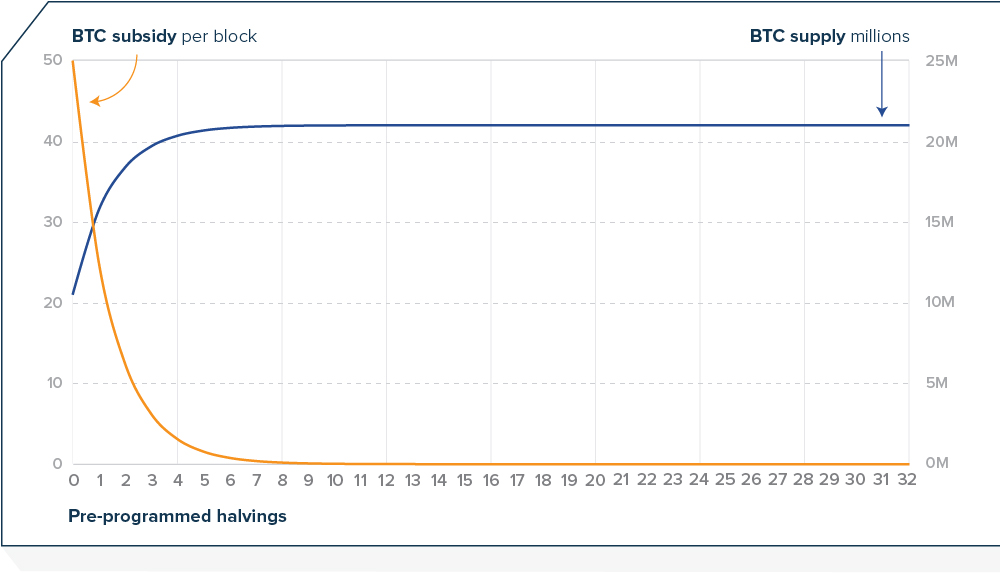
When the Bitcoin network first launched, the reward was initially set to ₿50, an amount that was high enough to quickly increase the money supply and incentivize miners to participate in the validation process. On November 28, 2012, that reward decreased by half to ₿25, then to ₿12.5 on July 9, 2016, and on May 11, 2020, to ₿6.25.
The last halving will happen sometime in 2136, with the reward decreasing to ₿0.00000001 or one satoshi, the smallest denomination of bitcoin possible. The last bitcoin will enter circulation four years later, in 2140.
Halvings and Miner Revenue
With the fourth halving just around the corner, some have wondered whether mining will still be sustainable. Modern mining operations today are costly endeavors, often with razor-thin margins, and losing half of one’s revenue overnight would be a nightmare for any business.
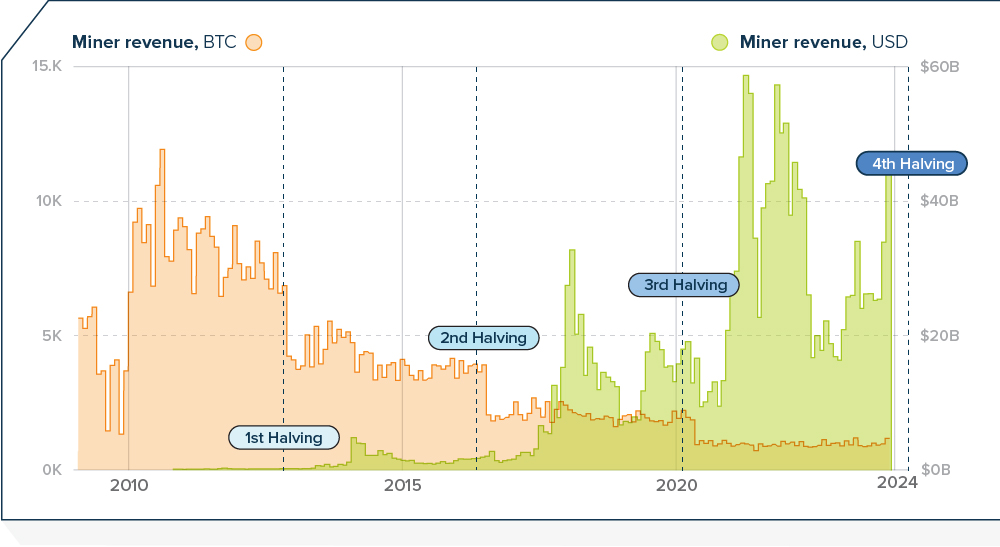
And if you look at historical miner revenue in bitcoin, you can see quite clearly, the steep drop in revenue after each halving. But what’s interesting, is that if you compare that against the miner revenue in USD, there is a drop there as well, but it recovers soon thereafter as the cryptocurrency appreciates. In other words, a miner may receive less bitcoin, but that bitcoin is worth more.
Halvings Compared
So we know that the network will continue to function after the fourth halving, but what else can we learn from previous halvings?
If we look at the percent change in market capitalization post-halvings, we can see a bit of a pattern. After both the second and third halvings, market capitalization peaked at around the year-and-half mark. The second-halving peak occurred on day 526 at around $328 billion, an increase of 3,000%, while the third-halving peak came three weeks later on day 547 at over $1.2 trillion, or an increase of just under 700%.
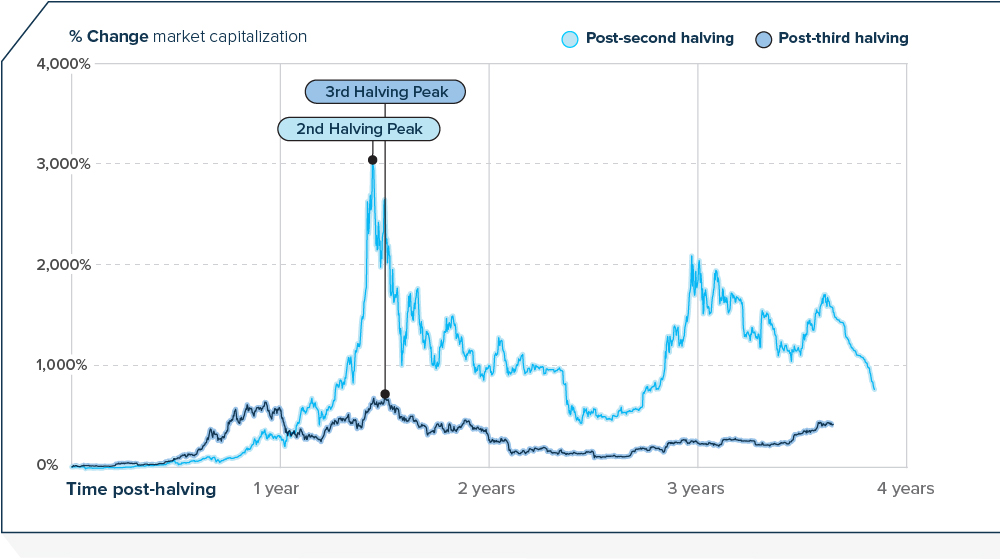
The post-first-halving peak happened a bit earlier, at the 372-day mark, but because the peak was so high (over 10,000%!) it is considered an outlier, and omitted to better illustrate the trend.
The 4th Bitcoin Halving Projected?
Because we know that halvings occur every 210,000 blocks and that each block takes around 10 minutes to mine, we have a good idea of when the fourth halving should happen: April 21, 2024. If the next halving follows the same pattern as the previous two, then there could be a market-capitalization peak some time during the third week of October 2025.
And with the price of bitcoin setting new records at time of writing, a lot of people will be watching very closely, indeed.

HIVE Digital is leading the way to a sustainable future for Bitcoin based on low-cost renewables.

-

 Energy3 years ago
Energy3 years agoVisualizing the Power Consumption of Bitcoin Mining
Bitcoin mining requires significant amounts of energy, but what does this consumption look like when compared to countries and companies?
-

 Bitcoin3 years ago
Bitcoin3 years agoBitcoin is Near All-Time Highs and the Mainstream Doesn’t Care…Yet
As bitcoin charges towards all-time highs, search interest is relatively low. How much attention has bitcoin’s recent rally gotten?
-

 Technology5 years ago
Technology5 years agoMapped: Cryptocurrency Regulations Around the World
Cryptocurrency regulations are essential for the future of digital finance, making it more attractive for businesses, banks, and investors worldwide.
-

 Technology5 years ago
Technology5 years agoMapping the Major Bitcoin Forks
Bitcoin forks play a key role in Bitcoin’s evolution as a blockchain. While some have sparked controversy, most Bitcoin forks have been a sign of growth.
-

 Cryptocurrency5 years ago
Cryptocurrency5 years agoThe Beginning of a Bitcoin Bull Run?
After 15 months of losses and stagnation, Bitcoin has made a miraculous recovery — going on a 150% bull run since its lows in December 2018.
-

 Bitcoin5 years ago
Bitcoin5 years agoDecentralized Finance: An Emerging Alternative to the Global Financial System
What is decentralized finance? Learn how technology is changing the rules of the game, creating the potential for a new financial system to emerge.
-

 Sports1 week ago
Sports1 week agoThe Highest Earning Athletes in Seven Professional Sports
-

 Countries2 weeks ago
Countries2 weeks agoPopulation Projections: The World’s 6 Largest Countries in 2075
-

 Markets2 weeks ago
Markets2 weeks agoThe Top 10 States by Real GDP Growth in 2023
-

 Demographics2 weeks ago
Demographics2 weeks agoThe Smallest Gender Wage Gaps in OECD Countries
-

 United States2 weeks ago
United States2 weeks agoWhere U.S. Inflation Hit the Hardest in March 2024
-

 Green2 weeks ago
Green2 weeks agoTop Countries By Forest Growth Since 2001
-

 United States2 weeks ago
United States2 weeks agoRanked: The Largest U.S. Corporations by Number of Employees
-

 Maps2 weeks ago
Maps2 weeks agoThe Largest Earthquakes in the New York Area (1970-2024)

